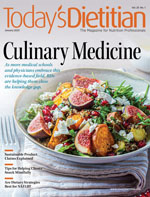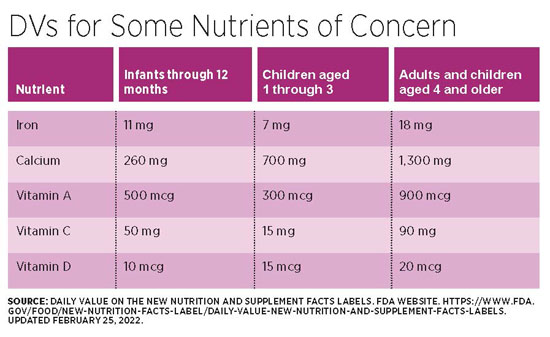 Supplements: Do Children Need Supplements?
Supplements: Do Children Need Supplements?
By Densie Webb, PhD, RD
Today’s Dietitian
Vol. 25 No. 1 P. 14
The Honest Answer: It Depends
As any parent of young children knows, kids can be notoriously picky eaters—no vegetables, only smooth textures, only white foods, only pizza. While common wisdom says children can get all the nutrients they need from a healthful diet, a recent poll found that more than one-half of parents say it’s difficult to get their children to eat a well-balanced diet.1 Some RDs say pediatric dietitians must find a way to counsel and console parents of picky eaters. One of the most common questions parents of young children pose to dietitians is, “Should I give my child a supplement?”
Children at Risk
Some children are at greater risk of nutrient shortfalls or even deficiencies, including those who follow vegan diets or who have been diagnosed with food allergies or celiac disease. Others at risk include children who drink plenty of sugar-sweetened beverages, those who take certain medications, and others living with food insecurity or who have chronic medical conditions that interfere with nutrient intake or absorption. In light of this, Jill Castle, MS, RDN, an author, a speaker, and founder and CEO of The Nourished Child, says, “I’ve noticed that ‘covering the bases’ has been a trend. Parents worry that their kids aren’t getting what they need, and a supplement gives them peace of mind.” She adds, “Research has shown that kids don’t get all they need from food alone. The goal we all have is to try to encourage children to get nutrients from the foods they eat, but to say it’s possible for everyone, isn’t practical.”
A national poll of 1,251 parents with at least one child aged 1 to 10, conducted by the University of Michigan Health, found that one-third of parents say their child is a picky eater, and one-third don’t think their child eats enough fruits and vegetables. The poll also found that three-fourths of parents have given their child a multivitamin. More than 1 in 5 had given their child omega-3 supplements.2 In general, female children and adolescents are more likely to take dietary supplements than males.3
The 2020–2025 Dietary Guidelines for Americans acknowledged that dietary supplements may be useful to compensate for nutrients that would otherwise be underconsumed.4
What’s in Children’s Supplements?
A recent study published in the Journal of the Academy of Nutrition and Dietetics found that the most common nutrients (in rank order) found in supplements for children were vitamins C, A, D, E, B6, and B12; zinc; biotin; pantothenic acid; iodine; and folic acid. Of the micronutrients (ie, vitamin D, calcium, and potassium) identified by the 2020–2025 Dietary Guidelines for Americans as nutrients of public health concern, 56% of children’s supplements contained vitamin D, 4% contained calcium, and none contained potassium. In addition, 49% of children’s supplements exceeded the upper tolerable intake level for folic acid, 17% for vitamin A, and 14% for zinc.5 The FDA doesn’t review or regulate dietary supplement products before they’re marketed. According to the Dietary Supplement Health and Education Act, manufacturers of supplements, whether for children or adults, are solely responsible for ensuring their products are safe and determining that the claims on their labels are accurate and truthful.
Too Little vs Too Much
Parents’ worries that their children may not be getting enough vitamins and minerals in their diet aren’t unfounded.5 According to the American Academy of Pediatrics (AAP), most children don’t get enough iron and calcium from foods. However, when supplements are introduced, there’s also the risk of children getting too much of one or more nutrients.
A study published last year in Nutrition and Health found that more than one-third of 52 child-friendly supplements purchased at US pharmacy chains contained amounts of vitamin A equal to or above the established tolerable upper limit for children aged 1 to 3; almost one-fifth of the samples had similar levels of niacin.6 A study from 2017 found that poison control centers in the United States received a call every 24 minutes, on average, with concerns about dietary supplement exposures in children. Many were herbal supplements, but sweet colorful vitamin and mineral gummies also can pose serious problems if mistaken for candy.7 According to the National Center for Complementary and Integrative Health, about 4,600 children go to the emergency department every year because of ingesting dietary supplements. Most took a vitamin or mineral when unsupervised. Child-resistant packaging is required only for dietary supplements that contain 250 mg or more of iron in a single container.8 Large doses of the fat-soluble vitamins (vitamins A, D, E, and K) can be toxic if kids ingest too much. Symptoms of vitamin or mineral toxicity include nausea, headaches, or diarrhea.9 The AAP recommends pediatric health care providers inquire about dietary supplement use among patients.10 However, a recent poll found that among parents who gave their child a dietary supplement, only 43% say they discussed supplement use with their child’s health care provider.1
Nutrition Facts Panels on Supplements
Amounts of vitamins and minerals in children’s (and in adults’) supplements vary greatly, and there are an infinite number of nutrient combinations. When checking nutrition facts panels on children’s supplements, it’s important to keep in mind that the % DV listed on most of them is for children and adults aged 4 and older unless otherwise indicated. And like food labels, the % DV is calculated based on 2,000 kcal per day—an amount that doesn’t apply to many young children. The % DVs for children aged 1 to 3 are based on 1,000 kcal per day. Labeling information on children’s supplements is inconsistent at best, making product comparisons difficult. For example, some children’s supplements list one % DV for children aged 1 to 3 on the nutrition facts panel, in addition to the % DV for individuals aged 4 and older, which includes all adults. In addition, the dosage for children is sometimes one-half tablet, something that easily can be overlooked. Products also have been found to list % RI (recommended intake), which isn’t an official term. And the term “natural” on labels doesn’t necessarily mean a supplement is safe. Federal regulations for labeling of dietary supplements, including those for children, are less strict than those for prescription and over-the-counter drugs.
The most up-to-date nutrient recommendations from the Institute of Medicine are the Reference Daily Intakes. Note that while the DVs in the chart, which are used on nutrition facts panels, are for only three age groups, the Reference Daily Intakes issued by the Institute of Medicine provide nutrient recommendations for six age groups for children. Still, Castle says, “I think giving a supplement should be based on what children are eating routinely and their nutrition status and not necessarily their age. That being said, it’s important to understand the nutrients [of concern] for different age groups, so you can be on the lookout for inadequacies in their eating patterns.” The nutrient needs of teenagers typically fall somewhere between those of children and adults, making it difficult to assess if they’re getting enough vitamins and minerals through their diets.

Bottom Line
It’s important to remember that every child is different and may have different nutrient needs. Because of that, most experts, including the AAP, don’t issue blanket recommendations for vitamin and mineral supplements for all children, with the exception of vitamin D and iron for infants. However, a 2021 market report found a significant increase in doctors recommending supplements to children.2 Castle says, “Parents should consult with their pediatrician, and dietitians should also be in communication with the pediatrician, particularly if they’re counseling to correct a known nutrient deficiency.”
— Densie Webb, PhD, RD, is a writer, editor, and industry consultant based in Austin, Texas.
References
1. Healthy eating and use of dietary supplements in children. Mott Poll website. https://mottpoll.org/reports/healthy-eating-and-use-dietary-supplements-children. Published April 18, 2022. Accessed October 8, 2022.
2. Mostafavi B. Half of parents regularly give kids a dietary supplement. University of Michigan website. https://healthblog.uofmhealth.org/childrens-health/half-of-parents-regularly-give-kids-a-dietary-supplement. Published April 18, 2022. Accessed October 8, 2022
3. Stierman B, Mishra S, Gahche JJ, Potischman N, Hales CM. Dietary supplement use in children and adolescents aged ≤ 19 years — United States, 2017–2018. MMWR Morb Mortal Wkly Rep. 2020;69(43):1557-1562.
4. US Department of Health and Human Services; US Department of Agriculture. 2015-2020 Dietary Guidelines for Americans. https://health.gov/sites/default/files/2019-09/2015-2020_Dietary_Guidelines.pdf. Published December 2015.
5. Dwyer J, Saldanha L, Bailen R, Andrews K, Pehrsson P, et al. Do multivitamin/mineral dietary supplements for young children fill critical nutrient gaps? J Acad Nutr Diet. 2022;122(3):525-532.
6. Samuel L, Ethan D, Basch C, Dunne S, Quinn C. An analysis of nutrient facts labels of pediatric multi-vitamin and mineral supplements: is there a risk of overexposure? Nutr Health. 2022;2601060221100926.
7. Rao N, Spiller HA, Hodges NL, et al. An increase in dietary supplement exposures reported to US Poison Control Centers. J Med Toxicol. 2017;13(3):227-237.
8. Do repackaged OTC vitamins/supplements have to be in childproof containers? PackingLaw website. https://www.packaginglaw.com/ask-an-attorney/do-repackaged-otc-vitaminssupplements-have-be-childproof-containers. Published August 6, 2007. Accessed October 7, 2022.
9. Ellis E. Does my child need a supplement? American Academy of Nutrition and Dietetics website. https://www.eatright.org/food/vitamins-and-supplements/dietary-supplements/does-my-child-need-a-supplement. Published September 28, 2021. Accessed October 7, 2022.
10. McClafferty H, Vohra S, Bailey M, et al. Pediatric integrative medicine. Pediatrics. 2017;140(3):e20171961.
